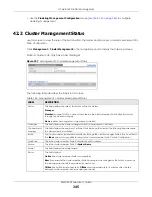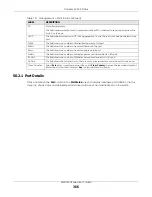
XMG1930 Series User’s Guide
355
C
HAPTER
45
ARP Table
45.1 Overview
This chapter introduces ARP Table.
Address Resolution Protocol (ARP) is a protocol for mapping an Internet Protocol address (IP address) to
a physical machine address, also known as a Media Access Control or MAC address, on the local area
network.
An IP (version 4) address is 32 bits long. In an Ethernet LAN, MAC addresses are 48 bits long. The ARP
Table maintains an association between each MAC address and its corresponding IP address.
45.1.1 What You Can Do
Use the
ARP Table
screen (
) to view IP-to-MAC address mappings.
45.1.2 What You Need to Know
When an incoming packet destined for a host device on a local area network arrives at the Switch, the
Switch's ARP program looks in the ARP Table and if it finds the address, it sends it to the device.
If no entry is found for the IP address, ARP broadcasts the request to all the devices on the LAN. The
Switch fills in its own MAC and IP address in the sender address fields, and puts the known IP address of
the target in the target IP address field. In addition, the Switch puts all ones in the target MAC field
(FF.FF.FF.FF.FF.FF is the Ethernet broadcast address). The replying device (which is either the IP address of
the device being sought or the router that knows the way) replaces the broadcast address with the
target's MAC address, swaps the sender and target pairs, and unicasts the answer directly back to the
requesting machine. ARP updates the ARP Table for future reference and then sends the packet to the
MAC address that replied.
45.2 Viewing the ARP Table
Use the ARP table to view IP-to-MAC address mappings and remove specific dynamic ARP entries.
Click
Management
>
ARP Table
in the navigation panel to open the following screen.
















































